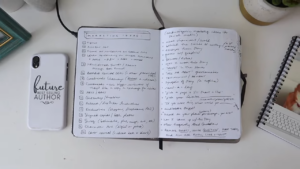One big part of making characters feel real is showing how they feel inside. But it can be tricky finding the balance between making emotions clear and making characters too aware of themselves.
This article talks about 10 ways to write how someone feels without thinking too much about it. Let’s take a look!
1. Show, Don’t Tell
A well-known writing tip is “show, don’t tell”. It’s better to let readers understand how a character feels through what they do, say or how their body looks, instead of just saying it.
For example:
- Telling: Sarah was sad.
- Showing: Sarah sat by the window watching the rain fall outside. Her shoulders were slumped and silent tears rolled down her cheeks as she looked out at the grey sky.
By showing readers instead of telling, your character doesn’t have to stop and think about how they feel. It helps readers figure it out themselves. Learning more about “show, don’t tell” can really improve stories. There are books that give clear examples and exercises to help writing feel more real. This helps readers connect better with the characters.
2. Use Metaphors and Similes
Comparing feelings to other things, like metaphors and similes, can make emotions more interesting to read about. It shows how characters feel in a visual way without them having to think about it.
For example:
- Instead of: Mark was scared.
- You could write: Fear came over Mark like a bad winter storm. It made his blood feel cold and his legs feel wobbly.
Putting feelings into pictures helps readers understand characters better without them having to stop and talk about how they feel.
3. Physical Manifestations

How someone feels often shows in their body too. Writing about these physical things is a good way to help readers understand a character’s emotions without them saying it out loud.
For example:
- Instead of: Jenny was nervous about the interview.
- You could write: Jenny’s stomach felt all tied up in knots as she went over her answers again. Her hands were sweaty and her mouth felt dry.
Showing emotions in the body makes stories more real. It helps readers connect with characters without them having to stop and say how they feel.
4. Use Dialogue
The way characters talk to each other can strongly show how they feel too. The words they choose, the sounds of their voice, and how fast or slow they speak paint a picture of emotions without them saying it.
For example:
- Instead of: Tom was mad at his boss.
- You could write: “You can’t be serious!” Tom’s voice boomed loudly in the office. His hands on the desk were clenched tightly, his knuckles turning white.
What people say and how they say it helps readers understand characters and their emotions really well without them stopping to bring attention to it.
5. Integrate the Setting

The place where the story takes place can quietly show how a character feels too. Describe things around them to match their emotions and set the tone without them saying it.
For example:
- Instead of: Kate felt alone.
- You could write: As Kate walked down the empty city streets, even the buildings seemed away from her. All their windows were shut, like they had closed eyes.
What’s around the character can reflect what’s inside them and helps the reader understand without it having to be said out loud.
6. Rely on the Character’s Actions
The little things characters do can show a lot about how they feel. Even small actions can give readers hints without saying it.
For example:
- Instead of: Brian was very worried about his mom being sick.
- You could write: Brian looked at his watch again, this was the third time in five minutes. His forehead was all wrinkled up. He kept holding his phone nervously, thinking about calling the hospital again.
A person’s behaviors quietly reveal their thoughts and feelings in a natural way, without stopping to bring attention to emotions.
7. Employ Subtext
The real meaning or feeling of what’s said can be a good way to show how someone feels without saying it out loud. This indirect way hints at the emotions underneath in a natural way.
For example:
Instead of: Laura was jealous of her sister.
You could write: “Wow another award? How do you fit them all?” Laura smiled but it didn’t reach her eyes as she cheered for her sister.
What’s implied tells readers about a character’s inner feelings while still feeling like a believable reaction for that person. It reveals emotion without the character acknowledging it directly.
8. Use Internal Monologue
Sometimes what a character thinks inside their head can give a peek at how they feel without being too aware. Just using it a little and focusing on their thoughts and what they notice instead of saying emotions directly works well.
For example:
- Instead of: John was afraid of the next fight.
- You could write: Pictures from the last battle kept coming into John’s mind—all the crazy fighting, yelling, and blood. He could almost hold his sword again, feeling how cold and stiff it was in his hands that wouldn’t stop shaking.
Letting readers see inside the character’s mind shows emotion without them having to label it themselves.
9. Describe Changes in the Character’s Routine

When a character does things differently from their usual, it can give a clue about changes in how they feel. By focusing here, you gently show emotion without them needing to say it directly.
For example:
- Instead of: Mia was heartbroken after the breakup.
- You might write: Mia’s coffee was left on the counter, getting cold. That morning ritual that always made her feel better now just brought back sad memories of times with her ex.
What someone does or doesn’t do compared to normal hints at inner feelings developing, without them having to notice it out loud.
10. Use Symbolism
Use Things that Mean Something
When certain things stand for feelings, it adds more detail and feels realistic. Readers can then figure out the character’s emotions themselves instead of being told directly.
For example:
- Instead of: Alex regretted his choice.
- You might write: The picture Alex ripped apart when he was mad was on the floor, just like what was left of his dreams.
Using symbols lets readers connect the dots about someone’s inner thoughts and feelings in a subtle, believable way for that person. It reveals emotion through what’s around them.
11. Emphasize Sensory Details

In reality, how we feel gets connected to our senses a lot. We link joy to the scent of something nice or stress to a sound that’s always there. Putting this into writing gives emotion context without directly addressing it.
For example:
- Instead of: Rita was depressed.
- You might write: Everything looked bleak and faded to Rita. Even the bright roses in her garden seemed dull and dried up, their sweet smell now almost too much to take.
Connecting feelings to the senses shows readers what emotion looks or smells like for that character in an organic way, without labeling the emotions outright.
12. Tap Into the Power of Pacing
The speed a story happens, and how long or short the descriptions are, help give hints about the characters too. Quick, choppy writing can show excitement or worry, while longer sentences show sadness or deep thinking.
For example:
- Instead of: Bill felt panicked.
- You could write: Bill’s thoughts sped by in a rush. No ideas, no time left. His heart pounded so loud and so quickly in his ears.
Pacing reflects inner feelings without directly saying words about emotions. Readers pick up on characters’ moods based on how swiftly or slowly they experience the story.
13. Contrast and Conflict

Struggles a character deals with, from others or themselves, give a window into feelings they don’t say directly. What’s causing trouble in their life shows inner emotional conflict without labeling it.
For example:
- Instead of: Elaine was caught between her job and her family.
- You might write: Elaine watched over her son as he slept, one hand holding her briefcase feeling very weighty all of a sudden.
What the character faces exposes inner emotions through their difficulties, in a natural way without announcing thoughts and feelings.
14. Use Flashbacks or Memories
Looking back at things they remember from before gives insight into how a character feels inside without them saying it directly.
For example:
- Instead of: Paul missed his childhood home.
- You could write: Paul dragged his fingers along the well-worn grooves of his childhood toy, each line taking him back down the happy echoes bouncing through the hallways of a home that now only lived in memories.
Letting readers see what someone recalls from earlier times or moments brings emotion to light through glimpses of their past.
15. Indirect Thoughts and Implications

What character chooses not to consider or talk about can show viewers emotion just as much as what they do say. When things are left on the page but not stated it tells readers truthful feelings someone avoids or doesn’t yet know about themselves.
For example:
- Instead of: Alice had fallen for her best bud.
- You could write: Alice saw him laughing, but her laugh got stuck coming out. Her eyes snapped over fast to the old love story sitting on her table, covered down—something left unopened just like the thoughts in her heart she pretended weren’t real.
Using what’s unsaid allows feelings to shine through for readers even as characters push those truths away or above their own awareness.
16. Rhythm and Repetition
The beat of the words and the reusing of certain phrases has ability to convey emotion too. The “tune” the writing plays can gently portray feeling without saying it directly.
For example:
- Instead of: Joe was mourning his loss.
- You might write: Joe walked through each day like in a daze, every moment a dull replay of the one before, every new sun just bringing the painful memory flooding back that was too tough to talk about.
Letting the flow and repetition of language work its way around what’s not said allows readers to feel the character’s inner world through a rhythm of words.
Final Thoughts
If we use these methods, we can bring feelings to life in stories in an honest, natural way instead of laying emotions out like a chore list. Readers won’t be informed how characters feel but they’ll experience it with them. After all, being human means we all know what it is to feel.
When we write emotions showing instead of telling, readers relate to characters from their hearts. Keep practicing bringing these techniques into the little details, keep observing real people and their reactions, and most of all keep sharing your gift for expression through your words! Stories can move people when they recognize shared truths.
I’m Anastasia, and I’ve just wrapped up my postgraduate studies in literature. I absolutely love writing books. It’s my way of weaving new worlds and breathing life into the characters that keep me up at night. Literature isn’t just a field of study for me; it’s a canvas where I paint with words. Through my writing, I hope to connect with others who share my love for storytelling and to contribute something meaningful to the literary world.
Related Posts:
- How to Self-Publish a Book - Insider Tips for…
- 7 Best Ways to Find the Right Editor for Your Book -…
- What Is a Secondary Character - How Do You Use It?
- Overcoming Writer’s Block - 10 Practical Tips for Beginners
- A Step-By-Step Guide to Writing Your First Novel -…
- How To Increase Your Productivity With A Writing Routine








